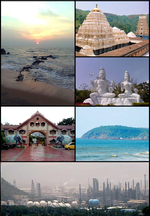
Visakhapatnam, also known as Vizag, Viśākha or Waltair, is the largest and most populous metropolitan city in the Indian state of Andhra Pradesh. It is between the Eastern Ghats and the coast of the Bay of Bengal. It is the second largest city on the east coast of India after Chennai, and the fourth-largest in South India. It is one of the four smart cities of Andhra Pradesh selected under the Smart Cities Mission and is the headquarters of Visakhapatnam district. With an estimated output of $43.5 billion, it is the ninth-largest contributor to India's gross domestic product as of 2016.

Vāsudeva I was a Kushan emperor, last of the "Great Kushans." Named inscriptions dating from year 64 to 98 of Kanishka's era suggest his reign extended from at least 191 to 232 CE. He ruled in Northern India and Central Asia, where he minted coins in the city of Balkh (Bactria). He probably had to deal with the rise of the Sasanians and the first incursions of the Kushano-Sasanians in the northwest of his territory.

The National Museum in New Delhi, also known as the National Museum of India, is one of the largest museums in India. Established in 1949, it holds a variety of articles ranging from pre-historic era to modern works of art. It functions under the Ministry of Culture, Government of India. The museum is situated on Janpath. The blue–print of the National Museum had been prepared by the Gwyer Committee set up by the Government of India in 1946. The museum has around 200,000 works of art, mostly Indian, but some of foreign origin, covering over 5,000 years.

Anakapalli is a residential neighborhood in the city of Visakhapatnam, also the headquarters of Anakapalli district of Andhra Pradesh. In 2015 Anakapalli municipality was merged with the Greater Visakhapatnam Municipal Corporation. It falls under zone 7 of GVMC. India's second largest jaggery market is located over here.

Nagarjunakonda: Nāgārjunikoṇḍa, meaning Nagarjuna Hill) is a historical town, now an island located near Nagarjuna Sagar in Palnadu district of the Indian state of Andhra Pradesh. It is one of India's richest Buddhist sites, and now lies almost entirely under the lake created by the Nagarjuna Sagar Dam. With the construction of the dam, the archaeological relics at Nagarjunakonda were submerged, and had to be excavated and transferred to higher land, which has become an island.

The National Museum of Indonesia is an archeological, historical, ethnological, and geographical museum located in Jalan Medan Merdeka Barat, Central Jakarta, right on the west side of Merdeka Square. Popularly known as the Elephant Museum after the elephant statue in its forecourt, its broad collections cover all of Indonesia's territory and almost all of its history. The museum has endeavoured to preserve Indonesia's heritage for two centuries.

Sarnath Museum is the oldest site museum of the Archaeological Survey of India. It houses the findings and excavations at the archaeological site of Sarnath, by the Archaeological Survey of India. Sarnath is located near Varanasi, in the state of Uttar Pradesh. The museum has 6,832 sculptures and artefacts.
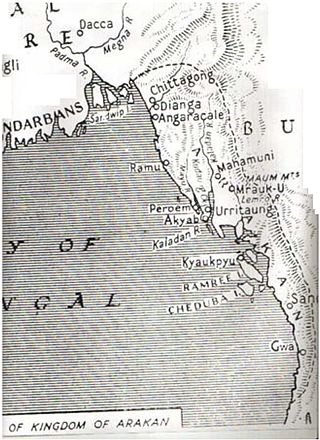
Rakhine State occupies the northern coastline of Myanmar up to the border with Bangladesh and corresponds to the historical Kingdom of Arakan. The history of Rakhine is divided into 7 parts - the independent kingdoms of Dhanyawadi, Waithali, Lemro, Mrauk U, Burmese occupation from 1785 to 1826, British rule from 1826 to 1948 and as a part of independent Burma from 1948.

Thotlakonda Buddhist Complex is situated on a hill near Bheemunipatnam about 15 kilometres (9.3 mi) from Visakhapatnam in Andhra Pradesh, India. The hill is about 128 metres (420 ft) above sea level and overlooks the sea. The Telugu name Toṭlakoṇḍa derived from the presence of a number of rock-cut cisterns hewn into the bedrock of the hillock. In 2019, the stupa was partially damaged due to monsoons, but it was restored by 2021 at the cost of Rs 42 lakh.
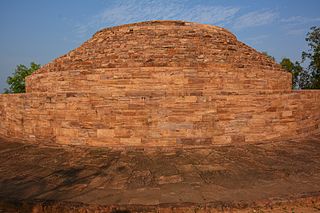
Lalitagiri is a major Buddhist complex in the Indian state of Odisha. The complex is home to stupas, 'esoteric' Buddha images, and monasteries (viharas), which is the oldest site in the region. Significant finds at this complex include Buddha's relics. Tantric Buddhism was practiced at this site.
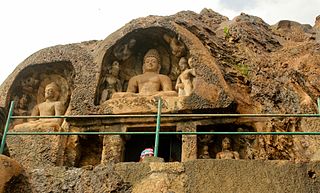
Bojjannakonda and Lingalakonda are two Buddhism rock-cut caves on adjacent hillocks, situated near a village called Sankaram, Anakapalle of ancient Kalinga. in the Indian state of Andhra Pradesh. The sites are believed to date between 4th and 9th Century A.D, when Buddhism is the majority religion of Sankaram. The original name of Bojjannakonda is Buddina Konda.
The Five Hundred Lords of Ayyavole were a merchant guild from Aihole that provided trade links between trading communities in Tamil Nadu, Karnataka and Andhra Pradesh. They have been mentioned in inscriptions from the 9th century CE. Aihole was formerly a major city of the Chalukyas of Badami and a place with many temples and brahmans, some of whom seem to have become involved in the trading activities of the Five Hundred. But most of the Ayyavolu Lords were merchants, especially those engaged in long-distance trade. Their inscriptions between the 9th and 14th centuries record their endowments made to temples and throw light on their trading activities or commodities.

Sri Ksetra, located along the Irrawaddy River at present-day Hmawza, was once a prominent Pyu settlement. The Pyu occupied several sites across Upper Myanmar, with Sri Ksetra recorded as the largest, the city wall enclosing an area of 1,477 hectares, although a recent survey found it enclosed 1,857 hectares within its monumental brick walls, with an extramural area of a similar size, being the largest Southeast Asian city before Angkor times. Issues surrounding the dating of this site has meant the majority of material is dated between the seventh and ninth centuries AD, however recent scholarship suggests Pyu culture at Sri Ksetra was active centuries before this.

Bavikonda Buddhist Complex lies about 16 km from Visakhapatnam, in the Indian state of Andhra Pradesh, on a hill about 130 metres above mean sea level. The term Bavikonda in Telugu means a hill of wells. As per its name, Bavikonda is a hill which has wells for the collection of rainwater. Bavikonda Monastic ruins dates back to the 3rd century BCE.

The Buddhapad Hoard or Buddam Hoard is a large cache of Buddhist and Jain sculptures found near the town of Buddam in Andhra Pradesh, southern India. Since 1905, it has formed an important part of the British Museum's South Asian collection. Dating from 6th-8th centuries AD, the style of craftsmanship fuses the northern influences of the Gupta period with the southern traditions of the Deccan, which in turn greatly influenced Buddhist art in South East Asia in subsequent centuries.
Visakhapatnam Metro is a planned rapid transit system for the city of Visakhapatnam in Andhra Pradesh, India. The system is proposed to reduce traffic congestion as well as providing a modern and efficient public transport system in the city which became the largest city and the main hub for economic activity of Andhra Pradesh after the state's bifurcation. It will be the only Indian city which will have a combination of both metro and tram. Once constructed it will be the world's largest metro prepared in a PPP model. Initially proposed for Metro Rail alignment for a length of 42.55 km in the city. Now, Government have planned to expand the Metro Rail system to cover more routes in the city as well as in the VMRDA area.
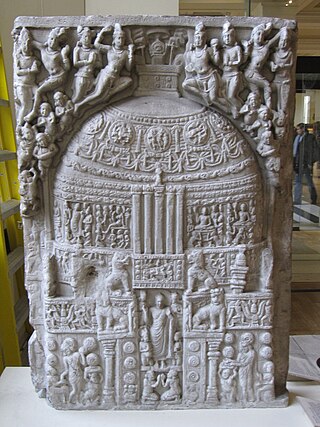
Amarāvati Stupa is a ruined Buddhist stūpa at the village of Amaravathi, Palnadu district, Andhra Pradesh, India, probably built in phases between the third century BCE and about 250 CE. It was enlarged and new sculptures replaced the earlier ones, beginning in about 50 CE. The site is under the protection of the Archaeological Survey of India, and includes the stūpa itself and the Archaeological Museum.

Chandavaram Buddhist site is an ancient Indian Buddhist site in Chandavaram village in Prakasam district in the Indian state of Andhra Pradesh. Situated on the bank of Gundlakamma River, the site is 10 kilometres (6.2 mi) northwest of Donakonda railway station. The Chandavaram Buddhist site was built between the 2nd century BCE and the 2nd century CE during the Satavahana dynasty and was discovered by Veluri Venkata Krishna Sastry in 1964.
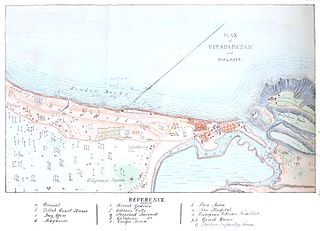
Visakhapatnam is a major metropolitan city in the state of Andhra Pradesh, and it holds the distinction of being the largest city in the state. The rich history of Visakhapatnam dates back over 2,500 years, with its present name potentially given by the Eastern Chalukyas king to their family deity, Visakha, in 1010 CE. Visakhapatnam, stepped into a history that spans millennia, was once part of the Kalinga Kingdom around 260 BC before coming under the influence of the Maurya Empire. During this period, Buddhism flourished, leading to the construction of significant monuments between the 2nd century BCE and the 2nd century CE. The city's documented existence begins in 1068 CE, under the rule of King Vishakhavarman. In the 7th century, Visakhapatnam witnessed the conquest of the Eastern Chalukyas, and by the 14th century, it became part of the Reddi Kingdom. The era of European colonization commenced in 1630 with the Dutch, followed by the British taking control in 1757 after a brief interlude of French influence. The Battle of Vizagapatam in 1804 during the Napoleonic Wars emphasized the strategic importance of the city. Following India's independence in 1947, Visakhapatnam became part of the Madras Presidency, later becoming an integral part of Andhra Pradesh. Today, it stands as the largest city in Andhra Pradesh, playing a pivotal role in the state's economy. The city's industrial growth saw a transformative phase with the inauguration of Visakhapatnam Port operations on December 19, 1933, firmly establishing it as a major industrial center.

The Buddha Preaching his First Sermon is a stone sculpture of the 5th-century CE showing Gautama Buddha in the "teaching posture" or dharmachakra pravartana mudrā. The relief is 5' 3" tall, and was excavated at Sarnath, India by F. O. Oertel during the 1904–1905 excavation season of the Archaeological Survey of India (ASI); it was found in an area to the south of the Dhamek Stupa.




















